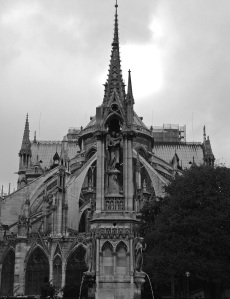Notre Dame Cathedral, Paris Photo: Armen Yesayan
So what makes today’s church architecture so different from the one developed until the 20th century? What does it lack in order to inspire us joy and humbleness? Is modern architecture truly incompatible with ecclesiastical designs? These are all difficult but fundamental questions for those interested in sacred architecture.
Traditionally, church buildings were easily distinguishable in the urban and rural landscape. In his book Ugly as sin, Michal Rose identified three key aspects, which he names natural laws, that made churches significant and poignant with meaningful architecture, transcending all periods of Christianity: verticality, permanence and iconography.He bases his arguments on the external and internal appearance of numerous churches and cathedrals around the world from late antiquity to industrial revolution and exemplifies them on the well known Notre Dame cathedral in Paris.
Notre Dame Cathedral, Paris Photo: Kent G Becker
However, the use of innovative materials and technology led to dramatic changes in the architecture of the late 19th century. Ironwork and concrete created new structural possibilities, allowing greater spans and heights to be achieved. Architects sought to express those engineering leaps through a new aesthetic which would celebrate the innovative materials and their (structural) function.
But what changed most the face of the 20th century architecture came perhaps from a cultural movement which originated in Zurich in 1916. Born as a reaction against the horrors of the World War I, Dada movement rejected aesthetics and intellectual conformity in favour of ostentation, degradation and demoralisation. The idea that man has no purpose and creation is meaningless would gradually lead to a culture of relativism and subjectivity, where an object is art simply if the artist believes it so.
This post-functionalist absence of meaning is, of curse, particularly damaging for ecclesiastical design. Although there are exceptions, the vast majority of churches built after 1930s represent self centred places which refuse to enter into a relationship with the transcendental, forcing the onlooker to focus inwards and search for meaning in things that are created, things that have a clear beginning and an end rather than point him towards the infinite. Many contemporary ecclesiastical buildings became for architects opportunities to test and try image driven ideas based on abstracted and over-rationalised perceptions of the world. The shift of emphasis from the ethical aspect of architecture to the visual has resulted in forms completely divorced from function.
Despite all this, modern forms of art and architecture are not intrinsically incompatible with church design. In the next posts I will try to analyse good as well as bad examples of churches built after 1900s and explore the question of how we can express anew the truth and eternal values in contemporary architecture.


